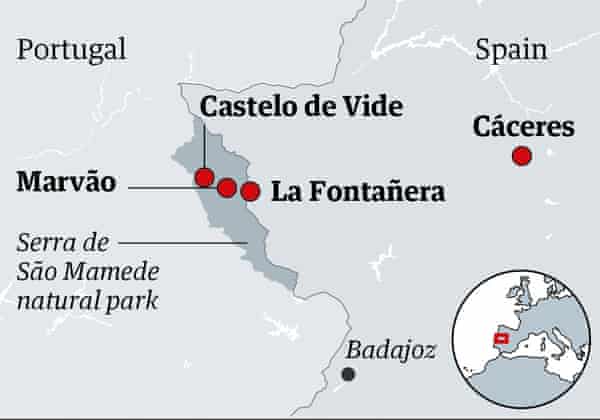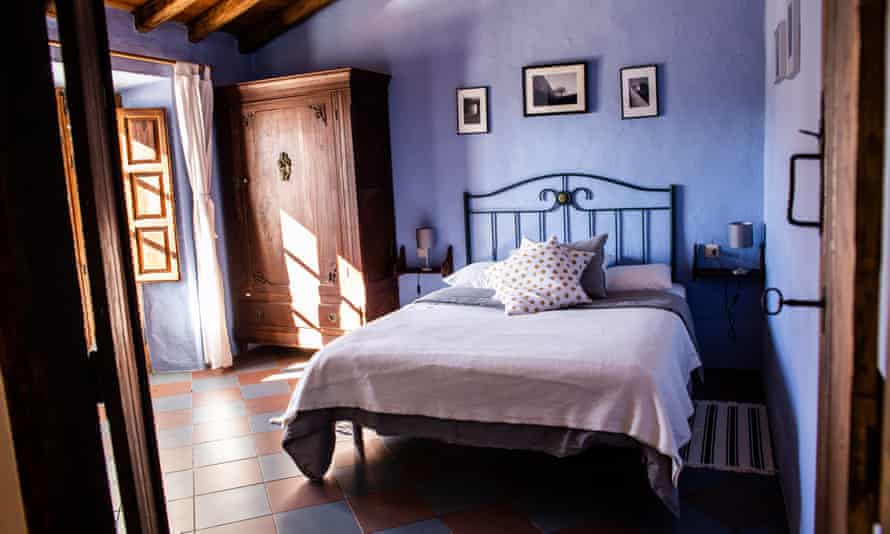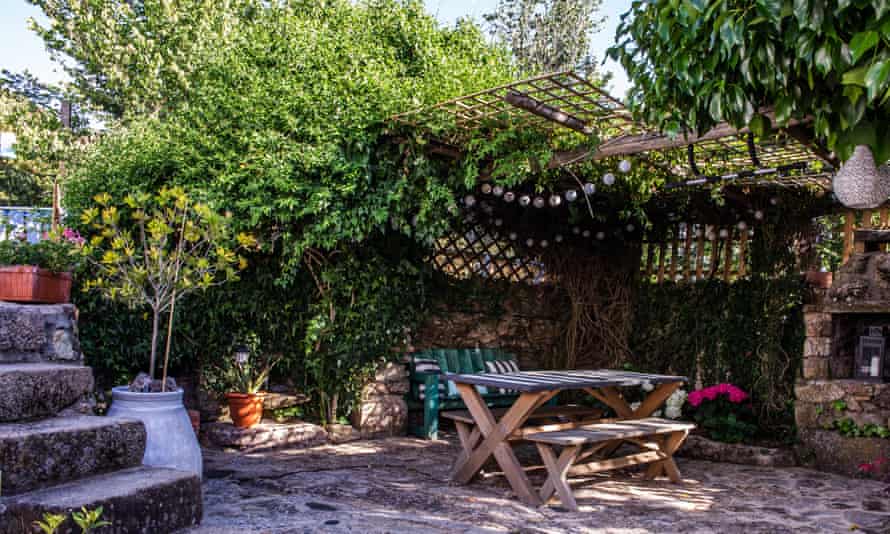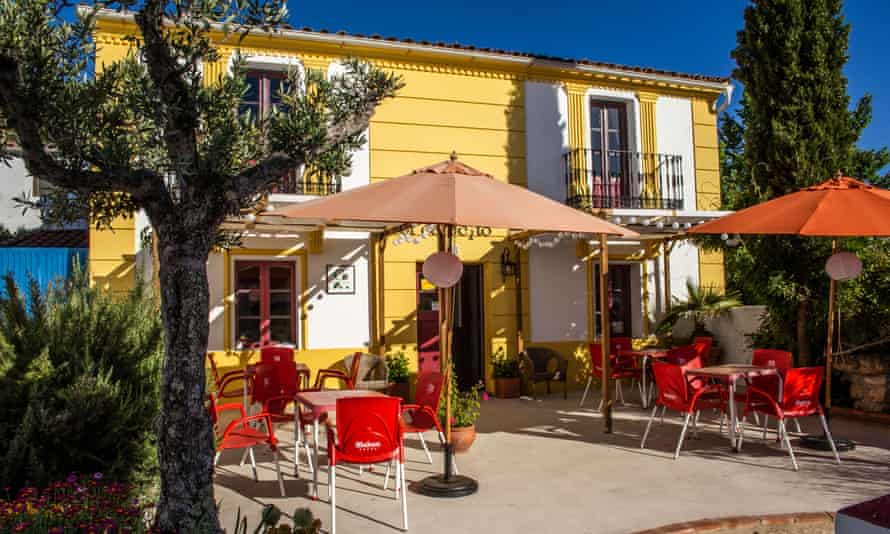“This whole area is riddled with smugglers’ paths.”
Pepe spread an arm out wide – some feat as we were cycling up a hill at the time – and indicated the expanse of undulating scrubland to our left. Peppered with cork oak trees, and with Spain’s sparsely populated Extremadura region immediately to the east, this part of Portugal was once ideal country for contrabandistas evading the Guardia Civil, the feared Spanish semi-paramilitary force that used to patrol the border.

I thought I knew a thing or two about Iberian history but a week in the little frontier village of La Fontañera was a real eye-opener. Even our lodgings – named Salto de Caballo (horse’s leap) – had played a dramatic role in events. “It used to be a casa de la duda [house of doubt] in no man’s land,” said the owner, Tamara. “The front door was in Spain and the back door opened on to Portugal – making it perfect for smuggling.”
Coffee, penicillin and leather boots were among the commodities often smuggled. However, basic necessities such as bread, cheese and garlic would also find their way across, feeding Spaniards impoverished by the civil war and the subsequent dictatorship.
We’d taken the train from London to Cáceres – spending a night in Madrid en route – and marvelled at a landscape that became ever more desert-like as we neared our destination. Unfortunately, the campaign to resurrect the rail service from Cáceres to Valencia de Alcántara (close to La Fontañera) has not yet achieved its goal, and with no bus between the two at weekends, we were obliged to hire a car for the last leg of our journey.

Built in the late 19th century, Salto de Caballo was once a rambling farmhouse-cum-bar. It has since been tastefully converted into a pair of self-catering apartments, a small cafe and Tamara’s living quarters, which meant she was usually on hand for advice or a chat. Our two-bedroom apartment was all tiles and beams on the ground floor, while a huge en suite room upstairs overlooked the lovely garden. Every day we ate in the shade of the garden’s trees, bearing figs, lemons, limes and oranges, while exotic flowers sprang from innumerable pots, and various cats (and Tamara’s dog) lay about in the shade. We’d come in early October but temperatures were still close to 30C, so we made good use of the garden’s plunge pool.

Almost as soon as we’d arrived, Tamara announced, “My friends Pepe and Rainer go out cycling every Sunday. Would you like to join them?”
While my companion politely declined, Tamara arranged for a local bike hire company to pop by early next morning with a steed for me. And so began a little Portuguese village-hopping, dolmen-spotting, griffon vulture-clocking adventure. We pedalled on traffic-free back roads to Beira to admire the beautifully tiled Portuguese railway station, now sadly used only by rail bikes. At each village we stopped at a bar for a beer and a chat with the locals. Porteñol – a Portuguese-Spanish mashup – is the lingua franca in these parts, but no one took wild offence when I spoke plain old Spanish – which is not always the case in Portugal.

At one bar, fellow drinkers gave me freshly picked morangueiro grapes that tasted of strawberries and were a popular ingredient in agua ardiente in the days when households had their own stills. One fabulously sun-wizened Portuguese gentleman told us: “In the days of smuggling, La Fontañera had 10 bars and several shops.” (It has none of either now.) He also told us terrifying tales of the Guardia Civil capturing smugglers, taking them into the bush and executing them. Apparently, it was “easier than doing the paperwork that accompanied an arrest”.
We devoted a day to exploring Cáceres, 100km east of La Fontañera. Founded by the Romans and rebuilt by the Moors, it’s a handsome city of expansive concourses and magnificent caramel-coloured stone walls. At the Museo de Cáceres we stepped down into the cool of a palatial Moorish cistern. The all-important holiday people-watching was carried out from a table outside a cafe called Chocolat’s, accompanied by coffee and a tostada. And there was still time to stop by a hatch at the closed convent of San Pablo to buy the heart-shaped biscuits called palmeras de hojaldre.

Back in Portugal, a seven-mile waymarked trail follows a centuries-old track between Marvāo and the equally venerable town of Castelo de Vide. The Portuguese side of the border is dominated by the Serra de São Mamede natural park, and we found ourselves ambling through thickets of oak under the gaze of a circling (and rather rare) Bonelli’s eagle.
The feeling of timelessness was enhanced by the medieval paving that still covers sections of the path, and by the old village spring at which we sought refreshment. At length we passed through the little town gate of Castelo de Vide, following its narrow stone streets to a cafe for beer in the shade before our bus conveyed us back to Marvāo.

The rest of the week passed in a languorous haze. We pottered around Valencia de Alcántara’s street market, picking up succulent padrón peppers to fry for dinner. We dropped into a festival in Marvão, watching belly dancers and walking the castle walls as the sunset bathed us in light the colour of nectarines. We enjoyed a history tour around Alburquerque’s lofty Castillo de Luna. And a man called Jeremias at Aguas Partidas farm sold us bottles of olive oil, insisting on treating us to several rounds of his homemade liqueur before the deal was struck.
When the frontier with Portugal opened in the 1990s, smuggling came to a halt, dealing a desperate blow to the local economy. But should it ever become a lucrative option again, don’t expect Salto de Caballo to play a leading role.
“The border got moved a few feet to the west,” Tamara told us. “So these days the whole house is in Spain.”





